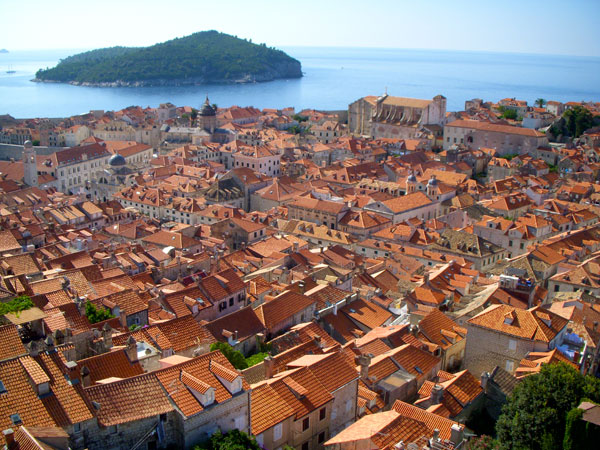JACOB STAPP CIGAINERO | Contributing Writer
jacobstapp@gmail.com
The Croatian seaside, when you see it, is one of those places you thought existed only in postcards and retouched brochures for faraway places. With a tumultuous history as part of the former Yugoslavia, Croatia isn’t how one might picture a once famously war-torn country. Independent Croatia (as of 1991) is fast becoming one of the hottest European beach destinations for its affordability and ecotourism offerings.
Situated on the Adriatic Sea, the Dalmatian Coast is anything but murky with its calm, crystalline waters ebbing from mint green to blue. White sailboats dot Croatian harbors, as waters lap against lush, tree-lined coasts while bathers relax on the picture-perfect beaches as islands with peak in the distance like a surreal painted movie backdrop.
Getting there is an adventure in itself. From Dubrovnik’s airport, you ride a bus that seems behemoth squeezing between the craggy cliff walls and railing that would surely prove useless if the vehicle were to careen against them. You know you’re heading somewhere worth the journey when signs warning of falling rocks greet you and the faint of heart hold their breath at every twist and turn.
Dubrovnik’s Old Town is a walled city dating to the 7th century, blanketed by orange tile roofs that reach out to sea. Churches, bell towers and official buildings overlook the condensed sprawl of ancient, simple architecture. The ash-cream colored streets are slick to the beachgoers’ flip-flops and double as a runway for the latest resortwear of Europe’s chic jet-set.
There’s no better way to start your day than with a pastry and coffee from Niko. This quaint, popular bakery stays busy in the morning with pick-me-ups and late, late night with its delicious sweets. Try a Turkish borek — a coil of flaky phyllo dough typically filled with cheese or minced meat — and find a seat on a shaded alley stairway to watch Old Town wake up. Afterward, shop for fresh fruits (including giant figs) in the open-air market. That’ll put you near the foot of the steps to the Rector’s Palace, close to the entrance to the top of the city’s walls, where you can take a morning stroll while enjoying a 360-degree view of Dubrovnik’s Old Town and the Adriatic.
The day heats up as the sun climbs high, and the beach is thankfully just a short walk from Old Town’s center. For those who grow restless lying on the beach, popular designer boutiques line the thoroughfares. Veering off the wide boulevards, you’ll stumble upon churches lit by shafts of sunlight illuminating faint pillars of dust.
Fresh seafood is the common fare in Old Town’s restaurants. If dining or drinking with a view, or in one of the often advertised garden terraces, you’ll most likely pay more for the ambience than for a quality meal. Seafood dishes are prepared simply and aren’t particularly spectacular. Sweet Croatian wines will interest oenophiles, and coffee enthusiasts will want to try bijela kava (white coffee), a mild, milky coffee. If you’re a fan of spirits, the Dalmatia specialty medica (meh-DEEtz-uh) is a honey liqueur that’s perfect for a post-dinner digestif. Anytime of day is great for Croatian gelato, and it is a close rival to Italy’s just west across the sea.
Consider escaping Dubrovnik for quieter scenery at least one day of the trip. Just a short 90-minute ferry ride from Dubrovnik’s harbor is the unspoiled island of Mljet, where Odysseus and his men were said to be held captive by the sorceress Calypso. The entire island is a national park of 10,000-year-old saltwater lakes and snaking limestone cliffs covered in verdant forests and fauna, creating hiking and biking trails for the more adventurous to explore the ancient stone villages in the hills. The island air vibrates with the constant buzz of cicadas and native birds calling over the hum.
Bike rentals, available immediately after docking, are a must. Biking up and down Mljet’s hills provides a fresh sea breeze in your face and stunning vistas of tranquil sailboats leisurely meandering along, as well as views of vineyards, olive groves and golden fields. (You can hike the sloping terrain for a more leisurely adventure.)
Although Zagreb is the hub of the gay scene in Croatia, there are things of gay interest around the country, including Dubrovnik, such as Lokrum Island, specifically catering to gay travelers and nudists. Otherwise, Mljet offers easy-to-find public swimming holes, but consider exploring more secluded areas to find your own piece of paradise. When you’ve found your perfect spot on the island, just a short climb down brings you to the water’s edge where you can set up for a picnic in the shade and a dip in the cool inlets. (Just watch out for the giant rust-colored jellyfish floating along the top of the top of the enticing waters. From land, those bulbous concavities breaking the surface look like sea turtles.)
Also, included in the entrance to the national park is a five-minute ferry ride to the interior island St. Mary, which houses an abandoned 12th century Benedictine monetary, where you can have a glass of wine to end your day before catching the sunset over the islands on the ferry ride back to Dubrovnik. Affordable and generous accommodations can be found in apartment rentals tucked away in one of the Old Town’s alleyways or overlooking one of its small plazas, or stay on the island to sample some of the limited accommodations available at Hotel Odisej (aptly named after Homer’s Odyssey). After exploring Croatia’s ancient walled cities, enchanted island forests, and swimming in unbelievably perfect waters, you may feel like you’ve been on an odyssey of your own.
This article appeared in the Dallas Voice print edition Feb. 11, 2011.

















